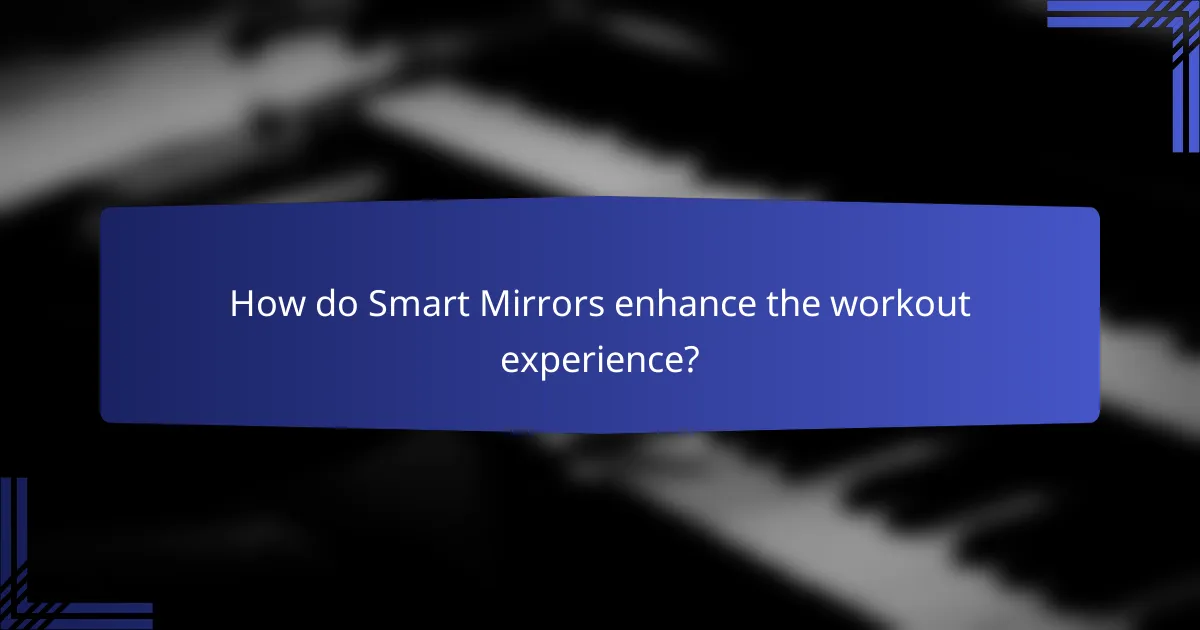When deciding between smart mirrors and traditional gyms, it’s essential to consider your personal fitness goals and lifestyle preferences. Smart mirrors offer the convenience of at-home workouts with personalized guidance, while traditional gyms provide access to a wide variety of equipment and social interaction. Understanding the costs and benefits of each option can help you make an informed choice that aligns with your needs.

Which fitness solution is more effective: Smart Mirrors or Traditional Gyms?
The effectiveness of smart mirrors versus traditional gyms largely depends on individual preferences and fitness goals. Smart mirrors provide personalized workouts in a convenient setting, while traditional gyms offer a broader range of equipment and social interaction.
Smart Mirrors offer personalized workouts
Smart mirrors utilize advanced technology to create customized workout plans tailored to individual fitness levels and goals. They often include features like real-time feedback, progress tracking, and a variety of workout styles, from yoga to high-intensity interval training.
This personalization can enhance motivation and adherence to fitness routines, making it easier for users to stay committed. Many smart mirrors also offer access to professional trainers through virtual classes, providing guidance without the need for a physical gym visit.
Traditional Gyms provide social interaction
Traditional gyms foster a sense of community through social interaction, which can be a significant motivator for many individuals. Working out alongside others can create a supportive environment and encourage accountability.
Group classes, personal training sessions, and casual conversations with fellow gym-goers can enhance the overall fitness experience. This social aspect can be particularly beneficial for those who thrive on teamwork and camaraderie.
Smart Mirrors are convenient for home use
Smart mirrors offer the convenience of working out at home, eliminating the need for travel and allowing users to fit workouts into their schedules more easily. This flexibility can be especially advantageous for busy individuals or those with family commitments.
Moreover, smart mirrors can be used at any time of day, making it easier to maintain a consistent fitness routine without the constraints of gym hours. This home-based approach can also save on gym membership fees, which can range from tens to hundreds of dollars per month.
Traditional Gyms have a wider range of equipment
Traditional gyms typically offer a diverse array of equipment that caters to various fitness activities, including weightlifting, cardio, and functional training. This variety allows users to engage in comprehensive workouts that target different muscle groups and fitness goals.
Access to specialized machines and free weights can enhance workout effectiveness and provide options for progression. For individuals focused on strength training or specific athletic performance, the equipment variety in traditional gyms can be a significant advantage over smart mirrors.

When should you choose Smart Mirrors over Traditional Gyms?
Smart mirrors are ideal when you prioritize home convenience and flexibility in your workout routine. They allow for personalized fitness experiences without the need to travel, making them a great option for busy individuals or those who prefer exercising in private.
Choose Smart Mirrors for home convenience
Smart mirrors provide a compact solution for home workouts, integrating technology with fitness. They often come with built-in trainers, offering guided sessions that can fit into your schedule. This means you can exercise at any time, whether it’s early morning or late at night, without commuting to a gym.
Additionally, smart mirrors typically require minimal space and can blend seamlessly into your home decor. This makes them suitable for apartments or smaller living areas where traditional gym equipment might be impractical.
Select Traditional Gyms for community support
Traditional gyms offer a sense of community that smart mirrors cannot replicate. Many people find motivation in group classes and the social interaction that comes from working out alongside others. This environment can enhance accountability and encourage consistent attendance.
Moreover, traditional gyms provide access to a wider variety of equipment and facilities, such as weights, machines, and swimming pools. This diversity allows for a more comprehensive workout experience that can cater to different fitness goals, from strength training to cardiovascular health.

What are the costs associated with Smart Mirrors and Traditional Gyms?
The costs associated with smart mirrors and traditional gyms vary significantly, impacting your decision on which fitness option to choose. Smart mirrors typically involve a one-time purchase price, while traditional gyms require ongoing monthly membership fees.
Smart Mirrors have upfront purchase costs
Investing in a smart mirror usually requires a substantial upfront payment, often ranging from several hundred to over a thousand dollars. This cost covers the device itself, which includes integrated technology for workouts, tracking, and interactive features.
When considering a smart mirror, factor in potential additional expenses such as subscription fees for workout programs or classes, which can add to your overall investment. It’s essential to evaluate how frequently you plan to use the mirror to determine if the initial cost is justified.
Traditional Gyms have monthly membership fees
Traditional gym memberships typically involve monthly fees that can vary widely based on location, amenities, and membership types. On average, you might expect to pay anywhere from $30 to $100 per month, with some premium gyms charging even more.
Keep in mind that many gyms also have initiation fees or contracts that lock you in for a specific period. When choosing a gym, consider the total cost over time, including any hidden fees, to ensure it aligns with your budget and fitness goals.

How do Smart Mirrors enhance the workout experience?
Smart mirrors enhance the workout experience by providing interactive features that support users in achieving their fitness goals. They combine technology with traditional exercise, allowing for personalized training and immediate feedback.
Smart Mirrors provide real-time feedback
Smart mirrors offer real-time feedback by using built-in cameras and sensors to analyze your movements during workouts. This immediate analysis helps users correct their form, ensuring exercises are performed safely and effectively.
For instance, if you are performing a squat, the mirror can alert you if your knees are not aligned properly. This type of feedback can significantly reduce the risk of injury and improve workout effectiveness.
Smart Mirrors offer a variety of classes
Smart mirrors provide access to a wide range of fitness classes, from yoga and pilates to high-intensity interval training (HIIT). Users can choose classes that fit their schedule and fitness level, making workouts more flexible and enjoyable.
Many smart mirrors feature on-demand classes and live sessions, allowing users to engage with instructors and fellow participants. This variety ensures that workouts remain fresh and motivating, catering to different preferences and goals.

What are the limitations of Smart Mirrors compared to Traditional Gyms?
Smart mirrors provide a convenient way to work out at home, but they have notable limitations compared to traditional gyms. These limitations primarily include the absence of physical equipment and the lack of access to professional trainers, which can impact the effectiveness of workouts.
Smart Mirrors lack physical equipment
Smart mirrors typically offer virtual workouts and guided sessions, but they do not include physical equipment like weights, resistance machines, or cardio machines. This absence means users must rely on their body weight or purchase additional equipment to achieve a comprehensive workout.
For example, while a smart mirror can guide you through a yoga session or bodyweight exercises, it cannot provide the resistance training benefits of a squat rack or a treadmill. Users looking for a well-rounded fitness regimen may find that they need to supplement their smart mirror workouts with visits to a gym or home equipment purchases.
Traditional Gyms offer professional trainers
One significant advantage of traditional gyms is the availability of professional trainers who can provide personalized guidance and support. Trainers can assess individual fitness levels, create tailored workout plans, and offer real-time feedback on form and technique.
This hands-on approach can be crucial for beginners or those looking to achieve specific fitness goals. In contrast, smart mirrors may offer pre-recorded classes or virtual coaching, but they lack the immediate, personalized interaction that a trainer in a gym can provide.

How do Smart Mirrors and Traditional Gyms compare in terms of space requirements?
Smart mirrors require significantly less space compared to traditional gyms, making them ideal for home use. While a smart mirror can fit in a small room or even a corner, traditional gyms demand larger areas to accommodate various equipment and activities.
Smart Mirrors require minimal space
Smart mirrors are designed to be compact and versatile, often fitting into spaces as small as a few square feet. They can be mounted on walls or placed in corners, allowing users to exercise in their living rooms, bedrooms, or home offices. This flexibility makes them suitable for urban dwellers or anyone with limited space.
Additionally, smart mirrors often come with built-in technology that offers guided workouts, making it unnecessary to have bulky equipment around. Users can engage in a variety of fitness routines without needing a dedicated gym area.
Traditional Gyms need larger facilities
Traditional gyms require substantial space to house various fitness equipment, such as weights, cardio machines, and exercise classes. A typical gym can range from several hundred to thousands of square feet, depending on the services offered. This space is essential for providing a safe and comfortable environment for multiple users.
Moreover, traditional gyms often include amenities like locker rooms, showers, and group class areas, which further increase their space requirements. For those considering a gym membership, it’s important to evaluate the available space and how it fits into their lifestyle and fitness goals.

What are the emerging trends in home fitness technology?
Emerging trends in home fitness technology include smart mirrors, virtual reality workouts, and AI-driven personal training. These innovations aim to enhance user experience, provide personalized guidance, and integrate fitness seamlessly into daily life.
Smart Mirrors
Smart mirrors are interactive devices that display workout routines, track performance, and offer real-time feedback. They often come with built-in cameras and sensors to analyze movements and provide corrections, making them a valuable tool for home workouts.
When considering a smart mirror, look for features such as a wide range of classes, community engagement options, and compatibility with fitness apps. Prices typically range from a few hundred to over a thousand dollars, depending on the brand and features.
Virtual Reality Workouts
Virtual reality (VR) workouts provide an immersive fitness experience by placing users in engaging environments while exercising. This technology can make workouts more enjoyable and motivate users to stick to their fitness routines.
To get started with VR workouts, you’ll need a VR headset and compatible fitness applications. Costs for VR headsets can vary widely, from a couple of hundred to several hundred dollars, depending on the quality and features.
AI-Driven Personal Training
AI-driven personal training utilizes algorithms to create customized workout plans based on individual goals, fitness levels, and preferences. This technology can adapt routines in real-time, ensuring users receive optimal guidance and support.
When exploring AI personal training options, consider platforms that offer user-friendly interfaces and a variety of workout types. Subscription costs for these services usually range from $10 to $50 per month, depending on the features and level of personalization offered.
